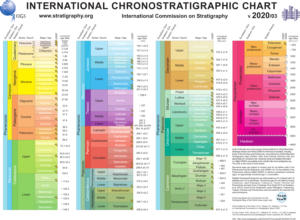“Extraordinary claims demand extraordinary evidence” – Carl Sagan
Our next episode on Topical Paleolimnology examines the proposed new geological epoch in the history of the Earth – the Anthropocene (or “Age of Humans”). The definition of an epoch is complex, and paleolimnology may be fundamental to this one.
The “official” timeline of Earth history is defined by the International Commission on Stratigraphy, a subcommittee of the International Union of Geological Sciences (IUGS).
Two key questions must be answered to define a stage on the geologic time scale:
1) “When did the stage begin?”
2) “What is the geologic marker that defines the beginning of the stage?”
Stages are defined either “chronometrically” at a specific time (e.g. 4.6B years ago), or based on a stratigraphic marker associated with paleontological changes (mostly marine fossils). These definitions are referred to as a Global Boundary Stratotype Section and Point (GSSPs), or more colloquially as “golden spikes”, as they are locations where a literal golden spike is hammered into the rock.
To date, more than 60 golden spikes have been placed. Two are located in Canada, both in Newfoundland, Fortune Head (the boundary between the Precambrian Era and the Cambrian Period) and Green Point (the boundary between the Cambrian Period and the Ordovician Period).
For now, we continue to reside in the Holocene Epoch (i.e. the past 10,000 years since the last glacial period). The Anthropocene has not yet been formally recognised, and a Anthropocene Working Group has been tasked with identifying a suitable marker to define a new golden spike.
The criteria used to establish a GSSP include:
- The primary marker is typically the first appearance of a fossil species (there are also usually secondary markers such as other fossils, chemical signals, a geomagnetic reversal etc.).
- The horizon in which the marker appears should have minerals that can be radiometrically dated.
- The marker has to have regional and global correlation in outcrops of the same age.
- The outcrop must be located where it can be visited quickly, kept in good condition (e.g. a national reserve), located in accessible terrain, extensive enough to allow repeated sampling and open to researchers of all nationalities.
The selection of “when” is intrinsically linked to “what to use” for the marker. Fortunately, the “when” of the Anthropocene has been narrowed down to the mid-20th century, and the dawn of the Atomic Age.
Several broad categories of GSSP candidates have been put forward:
- marine anoxic basins
- coral reefs
- estuaries and deltas
- peat bogs
- snow/ice layers
- speleothems
- tree rings
- lakes at various latitudes
Our interest in the topic stems from the potential for the GSSP that defines the Anthropocene to be a lake. One proposed candidate is a meromictic lake we have discussed previously on the podcast, Crawford Lake in Milton, Ontario.
Lake sediments can provide some advantages over the (former) marine environments used for almost all previous GSSPs, particularly due to the short time scale involved (~70 years). When a decision is finally made, our entry into a new epoch will undoubtedly break into the news cycle. A huge number of textbooks will need to be updated, all the way down to “baby’s first book of dinosaurs”.
We’re looking forward to it.



